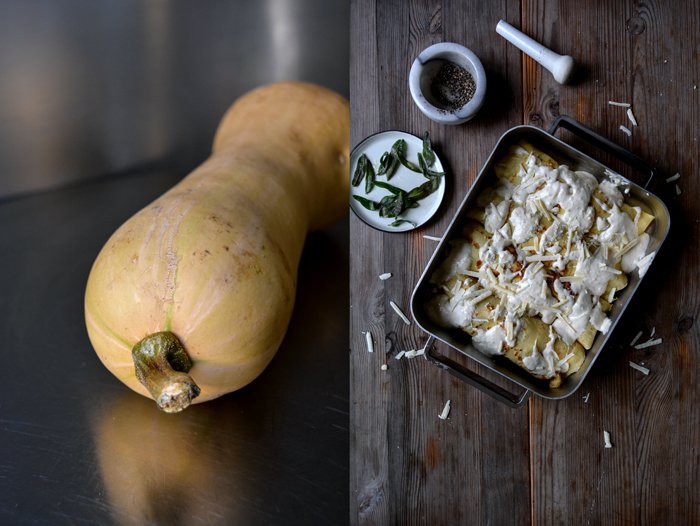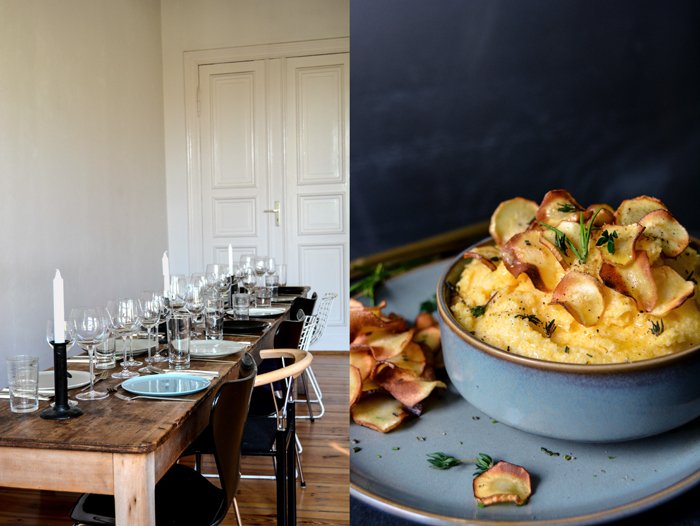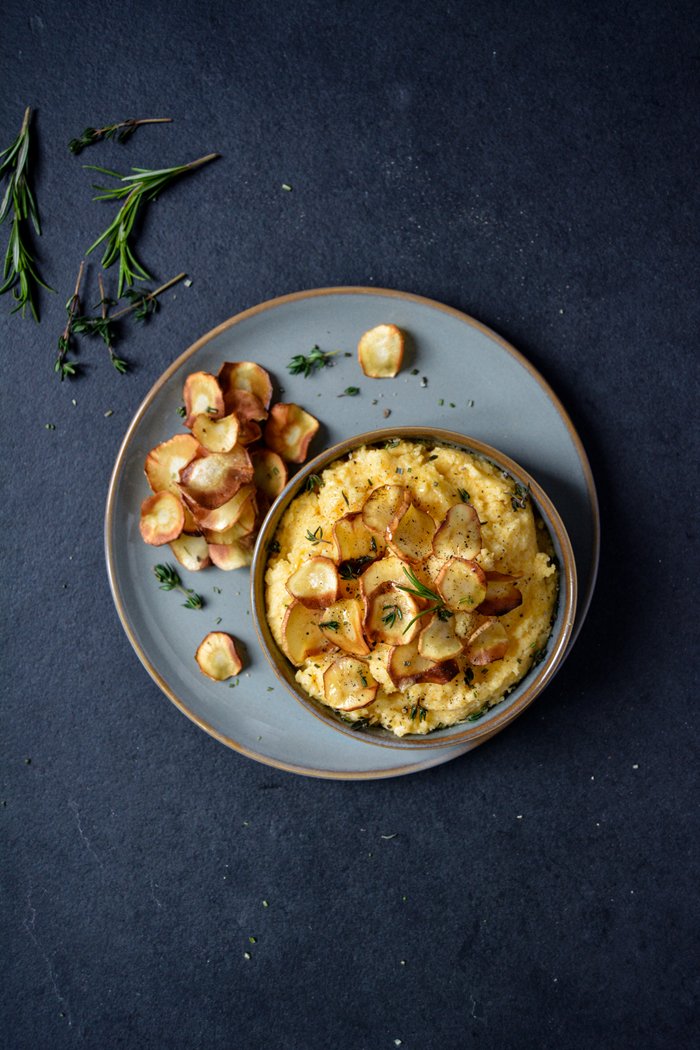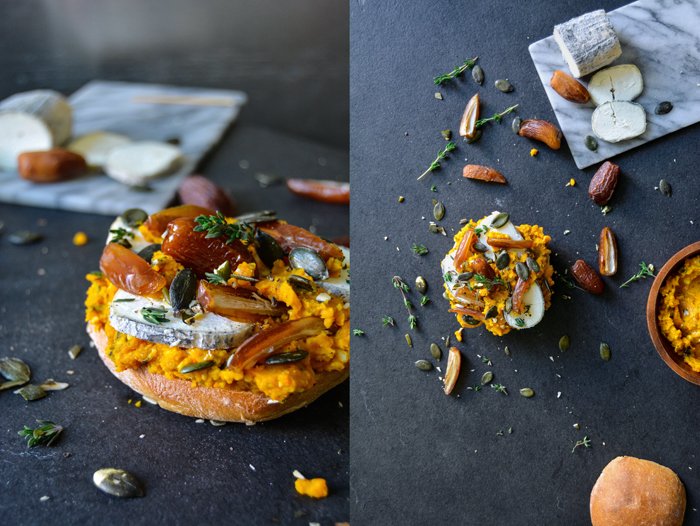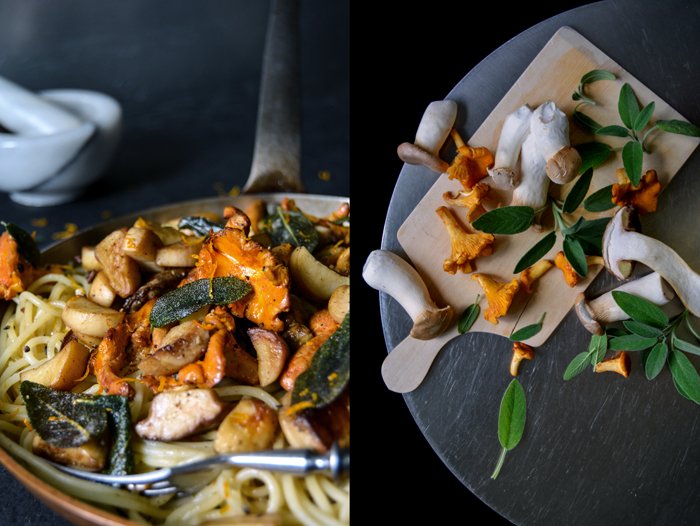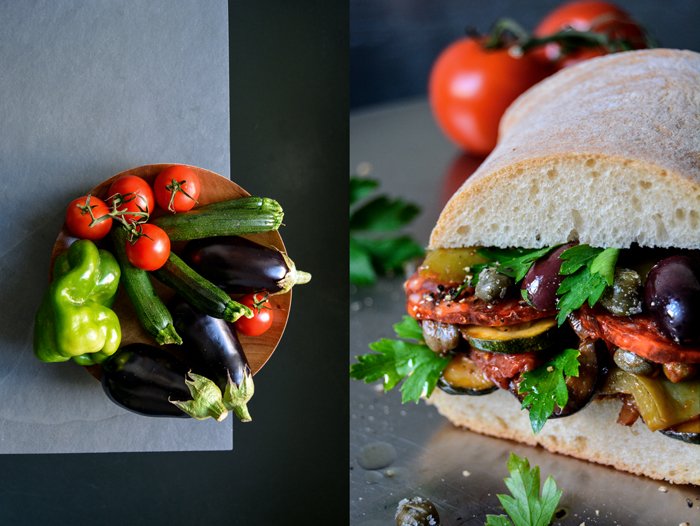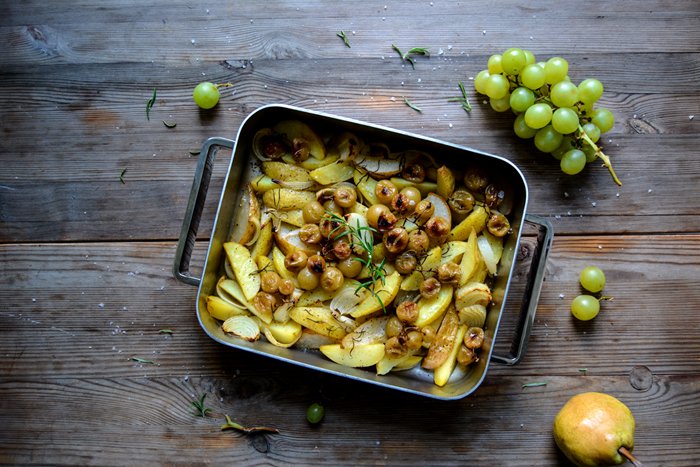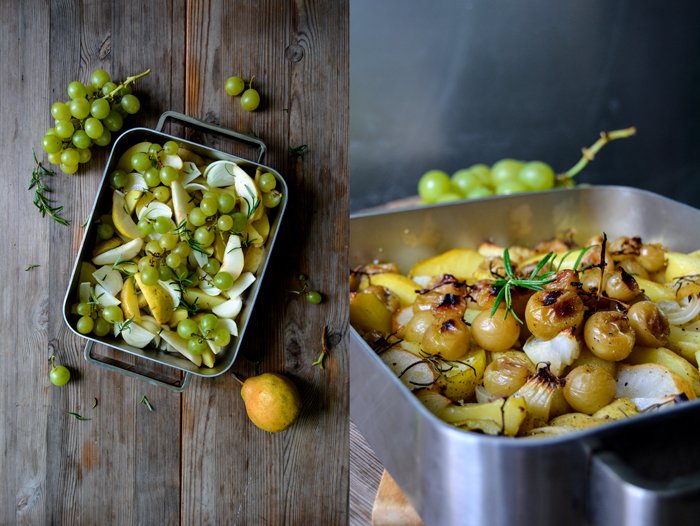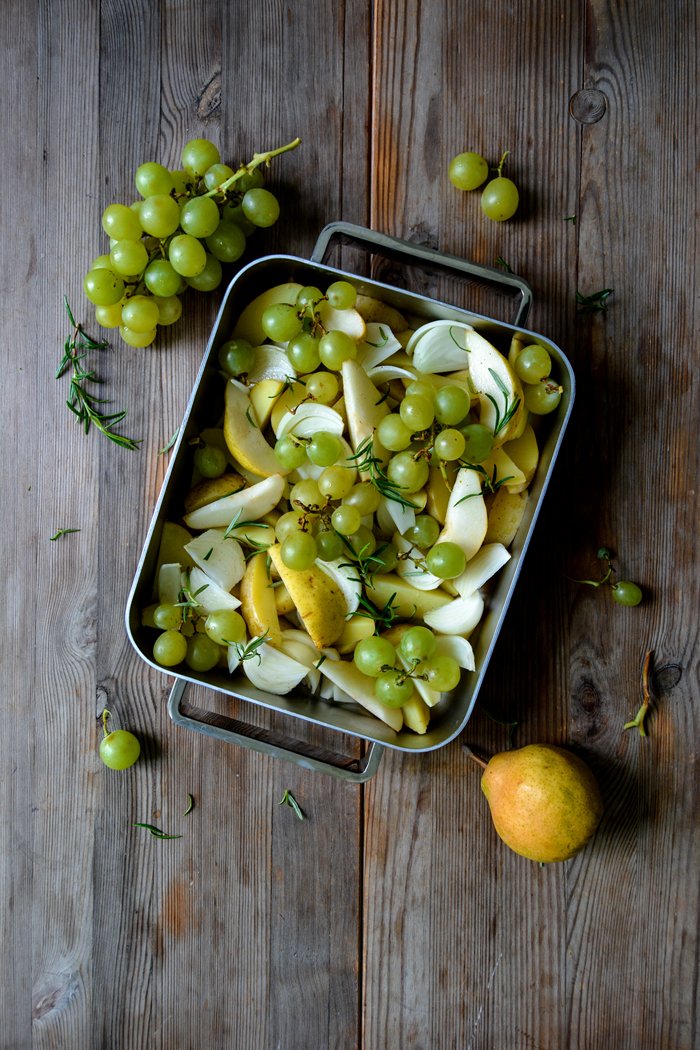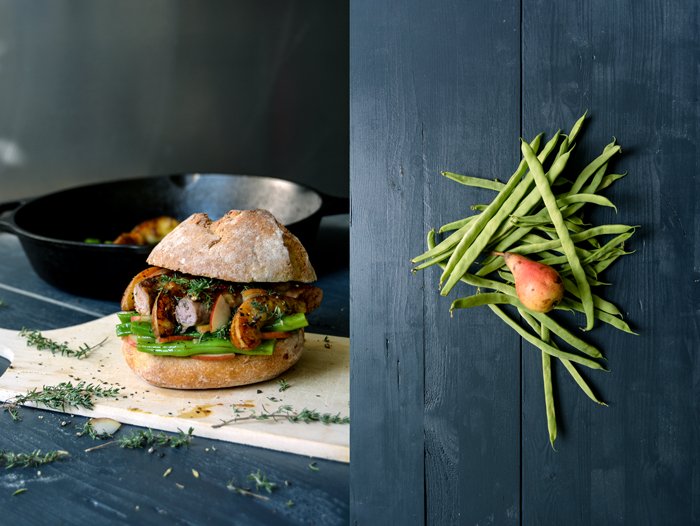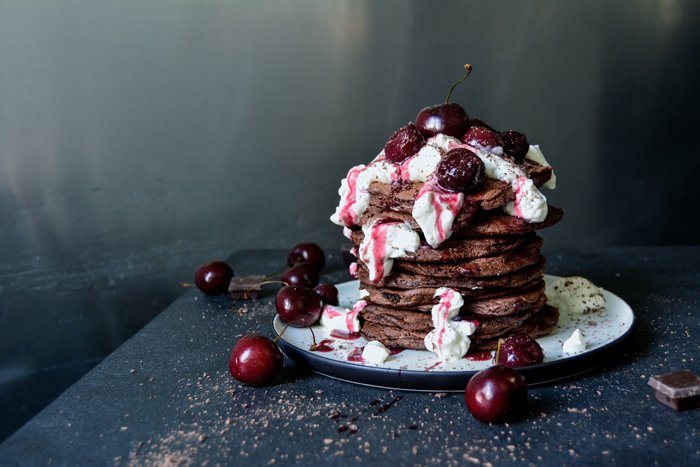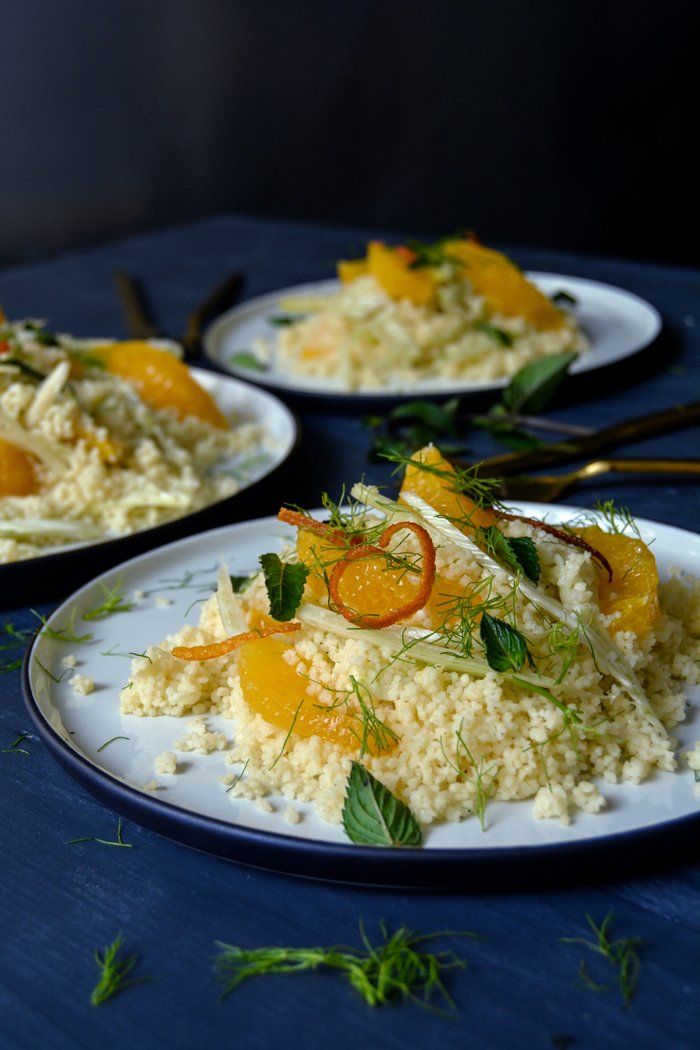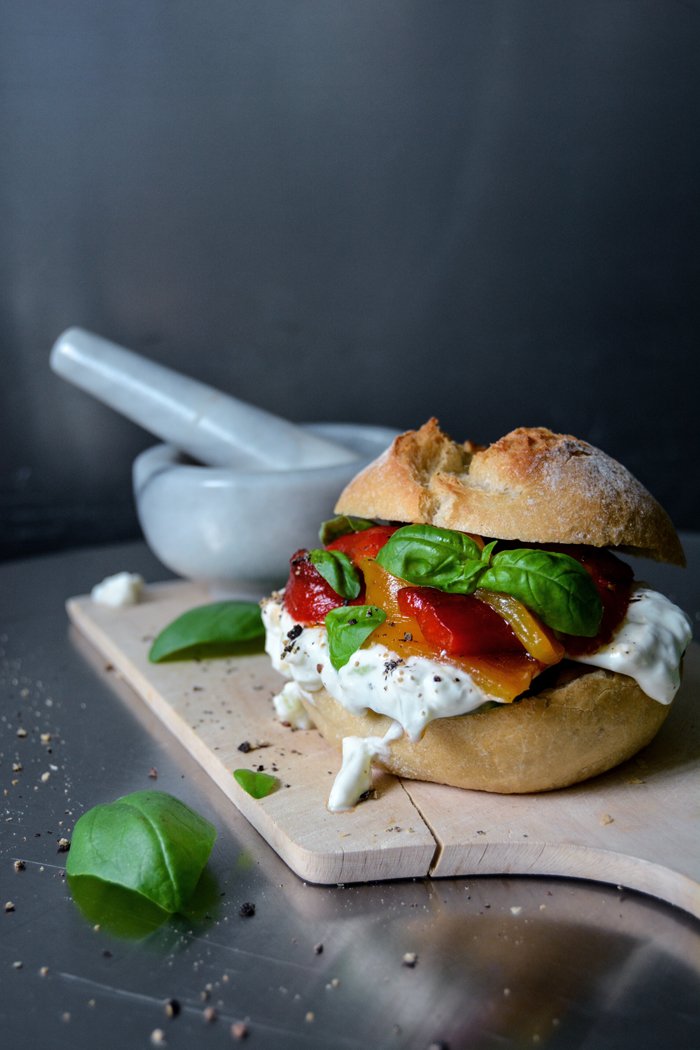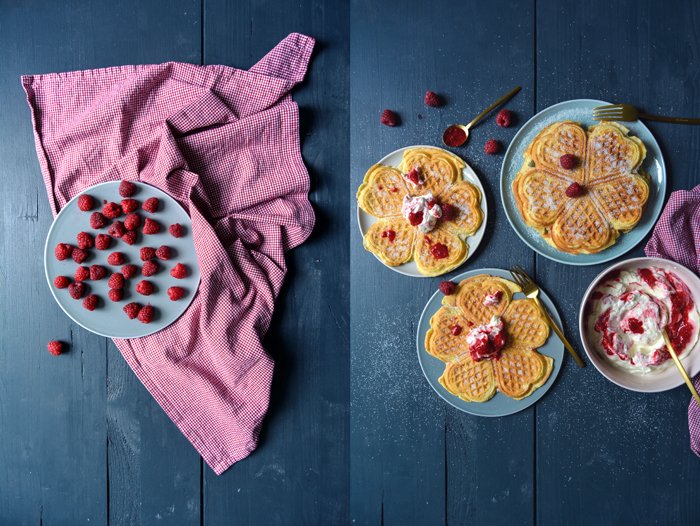Pumpkin Crespelle with Ricotta and Sage
Around Halloween, my boyfriend feels the call of his American roots and carves scary faces in pumpkins. Being a good girlfriend I know my duties, so I went out into the world - or rather my local shop around the corner - to find only the finest examples for him. I brought quite a pretty collection back home and let him do his work but I ended up with far more squash in my kitchen than we needed. We had a vast selection, a few Hokkaidos in different shapes and sizes and butternut, which isn't really helpful due to its shape but I forgot in my enthusiasm. So it was obvious, pumpkin had to be on the menu!
Thin, golden Italian crespelle have been on my mind for weeks but my inspiration was missing, I had no idea what to fill them with. Halloween's squash became my muse and here it is: roasted pumpkin cubes paired with a little ricotta, the obligatory creamy Béchamel sauce, Parmesan and crisp, fried sage leaves. It looked and tasted so good that my sister Nina, who's in Berlin at the moment for a quick visit, almost bit my laptop screen when she saw the pictures. We ate it all, so unfortunately, there was nothing left for her.
Pumpkin Crespelle with Ricotta and Sage
Makes 4 crespelle
For the filling
mixed pumpkin (squash), cut into 1 1/2cm / 1/2" cubes, 550g / 1 1/4 pounds (like Hokkaido (with skin), or peeled butternut and musquée de provence)
olive oil
flaky sea salt
butter 2 tablespoons
fresh, large sage leaves 30
fresh ricotta 4 heaping tablespoons
Parmesan, grated, 70g / 2 1/2 ounces
black peppercorns, crushed in a mortar
For the Béchamel sauce
milk 600ml / 2 1/2 cups
bay leaf 1
a pinch of nutmeg, freshly grated
fine sea salt
ground pepper
butter 30g / 2 tablespoons
plain flour 30g / 4 tablespoons
For the crespelle
milk 160ml / 2/3 cups
organic eggs 2
plain flour 130g / 1 cup
fine sea salt 1/4 teaspoon
butter, to cook the crespelle
Preheat the oven to 200°C / 390°F (conventional oven) and line a baking dish with baking paper.
Spread the pumpkin in the lined baking dish, coat with 2 tablespoons of olive oil, sprinkle with flaky sea salt and cook in the oven for about 25 minutes or until soft. Take the pumpkin out of the oven and set aside, keep the oven set to 200°C / 390°F.
For the Béchamel sauce, bring the milk with the bay leaf, nutmeg, salt and pepper to the boil, take it off the heat once boiled. In a saucepan, melt the butter and whisk in the flour, let it cook on medium heat for 1 minute. Take off the heat and slowly add the hot milk, whisk until smooth and cook for about 3 minutes on lowest heat until it’s thick and creamy. Discard the bay leaf, season to taste and set the pan aside.
Mix the ingredients for the crespelle with an electric mixer until well combined and let the dough rest for about 5-10 minutes. Heat a little butter in a large, heavy or non-stick pan and cook 4 large, very thin crespelle on medium heat until golden on both sides.
Heat 2 tablespoons of butter in a saucepan on high heat and roast the sage leaves for a few seconds in the sizzling butter until golden and crisp but not dark.
Lay each crespelle flat on a plate, spread with 1/4 of the pumpkin and sprinkle each of them with 2 1/2 tablespoons of Béchamel sauce, 1 heaped tablespoon of ricotta, 3 sage leaves, some Parmesan and crushed pepper. Roll into a tight wrap and place them next to each other in a baking dish. Pour the remaining sauce on top and sprinkle with Parmesan. Bake for 12 minutes or until golden brown, switch on the grill (broiler) for the last 1-2 minutes.
A juicy Lamb, Pomegranate and Pistachio Halloween Sandwich
This has been the longest sandwich break ever since I started my Sandwich Wednesdays almost 2 years ago - and I missed them badly. There's something deeply satisfying about creating a sandwich, taking the pictures of this luscious dish - and especially - eating it! It's back again and although it was supposed to be a Halloween sandwich I must admit that it didn't really work out. I expected my creation to look a bit messier, wildly dripping with red (pomegranate) juices, but it turned into a pretty sandwich beauty instead. Never mind.
Anyway, the flavours count more than the looks and they are more than promising in this recipe. A bit more than a year ago I shared my juicy lamb sandwich with preserved lemons and capers with you, it was a much loved and often featured sandwich that called for a new interpretation. Seared lamb fillet only needs a little salt and pepper to become the most tempting piece of meat you can possibly have on your plate, so there's no need to change the preparation. But this time the composition went into a different direction. Sour and salty gave way for sweet, sour and nutty. The fine taste of the fillets goes unbelievably well with the tangy, deep red juices of the pomegranate and unsalted pistachios. The topping of mint leaves should be handled with care. The herb can easily be too overpowering and I don't recommend using the whole leaves as you can see in the pictures but slice them thinly instead. Apart from this rule, you only have to stuff the composition between two slices of thick, juicy ciabatta - or even better, potato bread - and enjoy!
Lamb, Pomegranate and Pistachio Sandwich with Mint
If you don't feel like a sandwich enjoy the creation without bread, just juicy lamb fillets sprinkled with pomegranate, pistachios and crushed pepper.
Makes 4 sandwiches
olive oil
lamb fillets 250g / 9 ounces
fine sea salt
black peppercorns, crushed in a mortar
juicy, white bread 8 thick slices
fresh rocket leaves, a small handful
pomegranate seeds about 4 heaping teaspoons
unsalted pistachios, chopped, about 4 heaping teaspoons
mint leaves, thinly sliced, 8
Heat a splash of olive oil in a heavy pan and sear the lamb for 1 1/2-2 minutes on each side (not longer!), the meat should be pink and slightly undone in the middle. Season the fillets lightly with salt and pepper and wrap them in aluminum foil. Set them aside for a few minutes before you slice them thinly.
Brush the inside of the slices of bread with the juices from the pan and a little olive oil. Spread some rocket leaves on each slice of bread, lay a few slices of lamb on top and sprinkle with pomegranate seeds, pistachios, a little mint and crushed pepper. Close the sandwich and enjoy!
Herbed Polenta with Parsnip Chips and Maple Butter - and a feast!
The past few weeks have been an emotional roller coaster. I finished my English book and happily gave in all the recipes, text and pictures 3 days before my official deadline - something that had never happened before according to Holly, my editor, and it impressed her and the Prestel team in New York quite a bit. I just wanted to have everything off my desk at one point - and celebrate. And that's what we did!
Holly came to visit us in Berlin for a few days and all we did was talk and eat (and work on the cover for my book). We showed her around the city as it was her first time here and I planned a special dinner for her with some of the people at the table who have strongly influenced me during my eat in my kitchen blog and book experience. Not all of them could make it, but to see how many came and how some of them tried to make it possible truly touched me. Molly from My Name Is Yeh wanted to come from North Dakota just for this dinner, she even checked out the flights - this is crazy! - but she had to be in the States the day before and after. Thank you girl!!
Malin from The Bread Exchange came with her handsome baby boy Lode - in the early days of my blog we made sandwiches together with her bread and now we even share the same publisher (for her German book that will come out in the Spring of 2016). Marta from What Should I Eat For Breakfast Today? - my great inspiration for photography and positivity in life (this lady has the most beautiful smile!) and one of the first meet in your kitchen guests - was here to celebrate with us. And she took the pictures of us at the table, which I love because usually I'm the one taking pictures so I'm never in them. They truly show what a happy night we had, thank you Marta! Cynthia Barcomi - the founder of my favourite Berlin Deli - already had her cake for our dinner in the oven but sadly had to cancel at the last minute. Luckily, we didn't have to worry about having enough sweets on the table anyway. My apple cinnamon crumble was delicious and looked rather rustic next to Laura's elegant raw chocolate avocado cake. The Berlin Tausendsuend baker impressed all of us with her composition and took us right to chocolate heaven.
It was an amazing night with amazing people that I'll never forget. And a nice coincident gave us another reason to cling the glasses - in the same week of my deadline, my boyfriend finished the EP he produced for a fantastic artist from Australia. Josh The Cat happened to spend a lot of time at our apartment in the past few months for the production and became one of my book's first testers. He loved my recipes as much as I love his music and we shared far more than just food and songs this year, he and his girlfriend, the gorgeous artist Phia, became close friends of ours and we're more than sad that they'll soon leave us to go back to Australia. But I'm sure we'll hear more about their music soon!
A dinner becomes special through the people and conversations at the table, it's delicious through the right food - we enjoyed some of my book's recipes which I can't share with you yet - and it's a feast when you have good wine in the glasses. I have to send a big thank you to a man from the South and fantastic wine maker who made it possible for us to enjoy amazing wine on that special night. Martin took over the Weingut Robert Bauer - which is now called Martin Albrecht Weingut - more than 10 years ago, a wine maker who's filled my mother and step father's wine cellar since I was a child. You could certainly call it our family wine. With a family tradition of more than 400 years of producing wine, Martin comes from the right background to continue Mr. Bauer's philosophy of creating only the best wines - ohne Restzucker (without residual sugar). This is wine of the highest quality, which you can smell and taste with the first sip. We enjoyed an excellent Gelber Muskateller (Muscat) with an autumny, fruity soup and an outstanding 2012 Herbstnebel (Syrah, Cabernet-Sauvignon and Nebbiolo) with hearty lamb. I love this wine! We were over the moon with our treat from the Württemberg area. If you're looking for a wine, handpicked in old vineyards, a wine that guarantees to please your taste buds to the fullest and puts a smile on your face, get in touch with Martin through their website, or visit him in Flein (50km / 30 miles from Stuttgart). He also offers the best vinegars I know - his Balsamic Pear vinegar is one of my favourites, you can basically drink it off the spoon. Thank you Martin!
And thank you Holly for giving me a reason to bring all these great people together at our table!
I can't share the recipes with you from that night, we have to be a little more patient until my book comes out, but as we enjoyed a dish that featured scrumptious parsnip I decided to create a dish for you that fits the current mood of autumn and allows the roots to bring out their confident qualities - fluffy herbed polenta topped with crisp parsnip chips and sizzling maple butter.
Thank you to everyone who has been a part of this journey for making all this possible, it makes me a very happy person - and a happy cook!
Herbed Polenta with Parsnip Chips and Maple Butter
Serves 2
For the polenta
polenta 120g / 4 ounces
water 240ml / 1 cup
milk 240ml / 1 cup
salt 1 teaspoon
olive oil 2 tablespoons
For the parsnip chips
parsnip, very thinly sliced, 200g / 7 ounces
vegetable oil
fine sea salt
For the maple butter
butter 2 tablespoons
maple syrup 1/2-1 tablespoon
For the topping
fresh rosemary, finely chopped, 1-2 teaspoons
fresh thyme leaves, finely chopped, 1-2 teaspoons
ground pepper
In a saucepan, heat the water and milk, add the salt and bring to the boil. Take the pan off the heat, add the olive oil and polenta and whisk. Turn the heat down to the lowest setting and put the pan back on. Cook the polenta for 10 minutes, stirring and adding more water once in a while if necessary. When the polenta is thick and creamy, take if off the heat and season with salt to taste.
Heat a generous splash of vegetable oil in a heavy pan, the bottom should be covered. When the oil is hot, add the parsnip, just enough to lay them next to each other. Turn them after a few seconds and take them out immediately once they are golden and crisp but not too dark. Mind that they burn very quickly! Transfer the chips to kitchen paper and season with salt.
Melt the butter in a saucepan, whisk in the maple syrup when it's sizzling and take the pan off the heat.
Scrape the polenta into bowls and sprinkle with maple butter, parsnip chips, pepper and fresh herbs.
meet in your kitchen | Alex's Kusksu Soup with Beans, Goat Cheese & Eggs
I'm in love - with my dear Maltese / British kitchen hosts Alex and Benjamin, with their beautiful 400 year old palazzo in Zebbug, their wonderful friends who joined us for a delicious traditional lunch and with the most gorgeous kitchen island I've ever seen in my life. A huge slab of Carrara marble on top of a simple wooden shelf took my breath away as I walked into the gorgeous kitchen. It's one of those rooms that you never want to leave again. It's welcoming and cozy, with an old fire place on one side, sparkling copper pots and pans hanging on a long limestone wall and a rustic wooden table at a glass door facing a bright courtyard. Here, you can cook, bake, chop and stir in peace and with plenty of space. A lot of the fresh produce comes straight from the garden, the cheese is made by a lady who lives in the village and Alex has enough ideas, energy and creativity to throw fantastic dinner parties on a weekly basis. It's my Mediterranean heaven.
The house is a gem and every detail feels effortlessly right. Found and restored by Alex more than 20 years ago, he saw the old walls' beauty built of thick Maltese limestone. The charismatic man used his sense and sensitivity to bring his home's true soul to life. Alex believes that everybody can create a nice house but not necessarily a home - a home needs a past, present and future and this palazzo has plenty of them all. It's a peaceful oasis, tranquil and calm, in the middle of an ancient village. Hidden doors and winding corridors, steps and balustrades cut out of the island's typical golden stone turn it into a playful labyrinth. The rooms furnished with elegant antiques are surrounded by walls more than 1m (3 feet) thick, the charm is rather introverted, here, the focus isn't on the world outside but surprises with dreamy views onto the lush green garden and into the courtyard with an almost cloistral atmosphere.
We met to cook and what is more fitting in this scene than an old Maltese recipe - the traditional Kusksu. The locals call it peasant food, I call it the most comforting, nurturing and scrumptious soup. Thick like a runny risotto, it's made with lots of onions, concentrated tomato paste, fava beans and peas, enriched with Maltese short cut pasta - the Kusksu pasta resembling couscous - eggs poached in the fruity juices and Gbejna, the islands' fresh goat cheese. The soft egg and cheese melt into the soup and spread their fine flavors, it's delicious!
Alex uses the tasty greens from their garden in Gozo, Malta's sister island. The fertile soil around another old house of his - this time from the 18th century - supplies the passionate cook and his food loving sous chef Benjamin with fresh produce all year round. I have only seen pictures of Casa Mezzodì in the village of Kercem but it looks like paradise.
Alex loves to use his self-taught kitchen skills to treat his friends to casual lunches and extravagant dinner parties. I'm very happy to be one of them, thanks to Benjamin who I've been visiting for years due to his amazing treatments. Originally from London, Benjamin left England a while ago to live with his partner on the Mediterranean archipelago and work as a reflexologist. He is simply the best, he knows the foot map and its pressure points so well that I trust him blindly.
Kusksu - Maltese Pasta Soup with Beans, Peas, Eggs and Goat Cheese
Adapted from the fantastic 'The Food and Cookery of Malta' by Anne and Helen Caruana Galizia.
Serves 4
olive oil
medium sized onions, thinly sliced, 2
garlic, crushed, 2 cloves
tomato paste 3-4 tablespoons
water 2l / 8 1/2 cups
fava beans, fresh or frozen, shelled, the outer skin removed, 350g / 12 1/2 ounces
bay leaves 2
peperoncino, chopped, to taste
salt and pepper
Kusksu pasta (or any other rice-shaped pasta) 100g / 3 1/2 ounces
peas, fresh or frozen, shelled, 200g / 7 ounces
eggs 4-8
small fresh goat cheeselets (like Maltese Gbejna or soft Chèvre) 4-8
Parmesan, freshly grated
Heat a generous splash of olive oil in a large pan and soften the onions and garlic for about 10-15 minutes, they should be golden but not dark. Add the tomato paste and cook for 1 minute. Pour in the water, stir in the beans, bay leaves and peperoncino and season with salt and pepper. Simmer for about 30 minutes or until the beans are al dente. Add the pasta and cook on low heat for about 10 minutes, stir once in a while. Add the peas, take the pan off the heat, cover and let it sit for about 10 minutes. Season to taste. Gently slip the eggs and goat cheeselets into the hot soup and let them cook, covered, on low heat for a few minutes. Serve the soup when the egg whites are still slightly soft, sprinkle with Parmesan and black pepper.
What fascinates you about old houses - and especially - their restoration?
I have been very privileged in my life to have been able to do a job I thoroughly enjoy. In my opinion, old houses allow us to revisit the past, which although can never be recreated, is fascinating to dip in to. It gives me a great deal of personal satisfaction to revitalise a period building and adapt it to contemporary living, whilst preserving the atmosphere and charm of past centuries.
You collect antiques. Some say it's impossible to stop collecting once you got started, do you feel the same? Where do you look for new finds?
Some of us suffer from Horror Vacui, and I suppose it is fair to say that there is a magpie in all of us. However, jesting apart, an old house needs props, rather like a stage and it is the love of old houses which leads one to forming collections.I mainly find things at auctions and house clearance sales. I also like rummaging on the barrows at Portobello Road whenever I happen to be in London.
As a passionate cook you host wonderful lunches and dinner parties for your friends. How important are these gatherings for you?
I am a very gregarious person by nature and nothing gives me greater pleasure than to see friends and family gathered round the table sharing food I have prepared. Besides, houses need to be filled with laughter and friends, and our house really comes alive when we give a dinner or a lunch party. As my partner is British, we frequently have house guests to stay. This always presents an opportunity ask our Maltese friends to lunch or dinner to meet them.
When did you start cooking and who or what was your inspiration?
As I have always been (overly!) fond of my food, I remember experimenting with recipes at about 16. Although, I suppose that I started taking cooking seriously in my twenties. One of my earliest inspirations was the great Elizabeth David, who pushed boundaries in her time and was seminal in bringing the Mediterranean cuisine to the rest of Europe. Malta at the time was still very British, with a tendency towards food of the meat and two veg variety, in spite of the great choice of Mediterranean vegetables available in local markets. I discovered a worn paperback copy of Elizabeth David’s Italian Food in the local RSPCA second hand bookshop, and it was this publication that flung open the doors for using local ingredients, and I still dip in to it to this day. Later on I discovered The Food and Cookery of Malta by Anne and Helen Caruana Galizia, and this publication has been my most thumbed cookery book since, as it revives all the traditional and wonderful Maltese dishes.
Some of the fresh produce you use in your kitchen is grown by your gardner in Gozo, from Malta's sister island, where you also spend a lot of your time. What are the differences between living in Malta and in Gozo?
We are very fortunate to have a weekend house called Casa Mezzodì in the village of Kercem in Gozo, where the garden is looked after by a very special man called George Spiteri. George is passionate about growing indigenous crops using organic methods, and we are very privileged to be able to have these vegetables made available to us.Gozo is essentially composed of rural communities living off the land and the sea. In spite of the close proximity, Gozitan kitchens produce different fare to Maltese ones. Gozitans being particularly inventive with stretching ingredients, creating delicious pies and stews made with the wonderful vegetables and fresh fish available.While we rarely venture out to restaurants in Malta, in Gozo we take every opportunity to visit the charming fishing village, turned resort, of Xlendi which is a mere five minutes from our home. There, we visit our favourite waterfront restaurants, and especially enjoy the cheese-less Gozitan “pizza” or ftira as it is known locally, which is topped with unusual layers of thinly sliced potato, tomatoes, capers, olives, anchovies and onions. The freshness of the ingredients, without the heaviness of cheese, on the crispiest of bases is the most heavenly combination.
What do you love about the Maltese cuisine?
The most simple, and frugal of ingredients, are always transformed into delicious dishes, which never fail to please. The stuffing of vegetables with rice, or meat, or fish…the wonderful pies, the vegetable stews, all combine European and Arabic influences and truly reflect Malta’s extraordinary geographical location at the crossroads between North, South, East and West.
Where do you find inspiration for new creations in the kitchen?
This wonderful age of communication has meant that one can browse for hours through fascinating blogs, such as yours, exploring new territory. In a sense, other peoples kitchens are brought in to your own at the click of a mouse, and perhaps, we do not fully appreciate how previous boundaries have now come down.
What was the first dish you cooked on your own, what is your first cooking memory?
I made a pea soup using terribly uneconomical petit pois, and best quality bacon rashers which I had pilfered from the deep freeze in my parents’ kitchen. Despite the velvety sweetness, and the beautiful emerald green colour of the soup, my long suffering mother was unamused that I had helped myself to her ingredients!
What are your favourite places to buy and enjoy food in Malta?
I pay a weekly visit to the local farmers’ market at Ta’ Qali, which is about ten minutes from where we live. I have my favourite suppliers and will buy aubergines, green peppers and cauliflowers from Serafin, who comes from Siggiewi, which is a neighbouring village. I buy all my tomatoes, salads, cucumbers and qara baghli (the superb local sweet marrows) from Anna who hails from Mgarr. Of course, the produce is all seasonal, so it’s broccoli and cabbages in the winter, strawberries in the spring, and watermelons in the summer. I love cooking and eating according to the time of the year, and knowing that my ingredients have sometimes been freshly picked just hours before being brought to the market.Y
ou shared a recipe for Kusksu on eat in my kitchen, what are the memories you connect with this dish?
We always had Kusksu on Good Friday when we were children, as this dish satisfied the very strict Roman Catholic fasting obligations. Once you had eaten it for lunch, it was very filling and would keep you going until supper time. It is a firm favourite of mine as it truly reflects Malta’s cosmopolitan cuisine, and besides, I get to use the broad beans, peas, and onions which George Spiteri has grown in Gozo.
If you could choose one person to cook a meal for you, who and what would it be?
Kelina Sultana was a Gozitan cook who worked for dear family friends. Sadly she died some years ago, but her lampuki pie (local fish pie) was the best I have ever tasted, and I would love to taste it one more time.
You're going to have ten friends over for a spontaneous dinner, what will be on the table?
It depends entirely upon what is in the fridge! For example, looking right now it would probably be a pasta dish using a variety of fresh vegetables, or a risotto with some chicken stock I made yesterday.
What was your childhood's culinary favourite and what is it now?
As a child I loved my mother’s lasagne. Today it would be a risotto a la Milanese.
Do you prefer to cook on your own or together with others?
I am quite happy cooking on my own, but really appreciate it when my partner Benjamin offers his assistance as a sous chef.
Which meals do you prefer, improvised or planned?
Either, I have no preference at all. Both can be fun, and have their appeal.
Which meal would you never cook again?
Farfalle with strawberry sauce, courtesy of Sophie Grigson in the London Sunday Times. Fortunately, I had offered our guests a trio of pasta dishes, so it was easy to avoid the disastrous results of combining strawberries with pasta!
Thank you Alex!
Pumpkin Pesto, Date and Ripe Chèvre Sandwich
They are finally back on my windowsill - colourful pumpkins in all shades, shapes and sizes! At the beginning of a new season I tend to hoard nature's new produce like a squirrel. My excitement for the fruits and vegetables that I've been missing and looking forward to for months causes irrational behavior at the market. When I came home with enough pumpkin to feed a large Mediterranean family I thought it would be a good idea to purée one of them and make space on my crowded kitchen tops. I turned it into a pesto.
Pesto comes from the Italian word pestare, meaning to pound and to crush, herbs are the most common ingredient but vegetables are an equally delicious but often neglected addition. Broccoli, asparagus, beans, peas, there are no limitations. Winter squash is packed with taste and subtle sweetness, once puréed the texture is so smooth that it seems like pumpkin is practically made to become a pesto. You can use canned purée or cook the squash in the oven, which I always prefer, it tastes better. My bright pesto is refined with orange juice and zest, thyme and the vegetable's seeds. I went for Hokkaido as you can use its skin and I appreciate its nutty flavour, butternut or Musque de Provence work just as well. I'm sure it would be scrumptious stirred into warm spaghetti but I spread it voluptuously on a sandwich instead, with dried dates to enhance the sweetness and Sainte-Maure de Touraine affiné, an aromatic ripe Chèvre.
Pumpkin Pesto, Date and Ripe Chèvre Sandwich
You can also use the pumpkin pesto for pasta dishes.
Makes 3 sandwiches
dark buns, cut in half, 3
Sainte-Maure de Touraine affiné, sliced, 80g / 3 ounces (or any other aged Chèvre)
juicy dates, pitted, quartered, 3-4
fresh thyme leaves, 1 tablespoon
pumpkin seeds 1 tablespoon
black peppercorns, crushed in a mortar
For the pumpkin pesto
Hokkaido (with skin) or butternut squash (peeled), cut into cubes, 350g / 12 1/2 ounces
pumpkin seeds 2 tablespoons
olive oil 2 tablespoons
freshly squeezed orange juice 1 tablespoon
orange zest 1/4-1/2 teaspoon
fresh thyme leaves 1-2 teaspoons
salt
Preheat the oven to 200°C / 390°F (convection oven).
Spread the pumpkin in a baking dish and fill the bottom with water (about 60ml 1/4 cup). Wet a large piece of parchment paper, big enough to cover the baking dish and lay it on top of the pumpkin. Cook it in the oven for about 20 minutes or until tender but not mushy. Purée the pumpkin in a food processor, add the pumpkin seeds, olive oil, juice, zest, thyme and salt and purée until smooth. Season with orange, thyme and salt to taste.
Spread the pumpkin pesto voluptuously on the bottom side of a bun, lay the Chèvre on top and sprinkle with pumpkin seeds, dates, thyme and pepper. Enjoy!
Cumin Cinnamon Sweet Potato with Candied Lemon and Olives
The leaves on the vine in front of my kitchen window are changing their color and start falling as soon as the wind picks up. It's slowly getting colder in Berlin, my wool sweaters replaced my t-shirts and it hasn't taken long for cozy dishes to be back on my mind. Stews and pies, roasts and cookies - my cooking and baking is getting ready for the cold season. I bought the first quince for my spice and fruit flavoured brandy that I'll soon need for all those minced pies and fruit cakes. A pile of small lemons from my kitchen counter has been squeezed into a jar with lots of Mr. Cini's sea salt to preserve and soften them for aromatic lamb shanks. My mood leaves no doubt that I'm ready for winter to come.
I'll still wait a few more days before indulging in the bright orange pleasures of pumpkins, for now I'll enjoy the autumny warmth of sweet potatoes, chopped into chunks and sautéed in fragrant cumin and cinnamon oil. Red onions softened in their velvety juices, plump Kalamata olives stirred in at the end and a few parsley leaves sprinkled on top to wave goodbye to summer. I finished it off with a sweet and tart topping, candied lemon peel tends to stick to your teeth a little but it tastes so good in this composition that I'm willing to compromise.
Cumin Cinnamon Sweet Potato with Candied Lemon and Olives
Serves 2
olive oil
ground cumin 1 teaspoon
ground cinnamon 1/8 teaspoon
medium red onions, cut in half and quartered, 2
sweet potato, peeled, quartered and cut into 1 1/2 cm / 1/2" slices, 430g (15 ounces)
freshly squeezed orange juice 3 tablespoons
white wine 3 tablespoons
water 6 tablespoons
coarse sea salt
black peppercorns, crushed in a mortar
lemon zest 1 heaping teaspoon
Kalamata olives 6
a few parsley leaves
For the candied lemon peel
long, wide strips of lemon, peeled off the fruit with a vegetable peeler, 5 (without the white pith)
freshly squeezed lemon juice 4 tablespoons
water 4 tablespoons
granulated sugar 3 tablespoons
For the candied peel, bring the strips of lemon peel, juice, water and sugar to a boil in a saucepan and simmer for about 15 minutes until golden and soft but not dark. Set aside.
Heat a generous splash of olive oil with the cumin and cinnamon in a heavy pan. When the pan is hot, add the onions and cook for about 5 minutes on medium-high heat until soft, stir once in a while and mind that they don't turn dark. Add the sweet potato, stir well and cook for 2 minutes. Deglaze with the orange juice, pour in the wine and water and season with salt and pepper. Stir in the zest and turn the temperature down to a medium-low. Close the pan with a lid and cook for about 10 minutes until the potatoes are just soft but still in shape. Stir in the olives and season to taste, take the pan off the heat, cover and let everything sit for a few minutes.
If the candied peel became hard, put the saucepan back on the heat to soften them. Divide the sweet potatoes between the plates, sprinkle with crushed pepper, candied peel and fresh parsley.
Porcini and Chanterelles Spaghetti with Orange Butter and Sage
Three bags full of porcini, chanterelles and king oyster mushrooms fresh from the market and a sudden change of recipe: mushroom gnocchi were on my mind, aromatic porcini finely chopped and mixed into a soft potato dough, but kitchen life doesn't always go to plan. My recipe didn't work out at all. A complete kitchen disaster, which I had to save by turning the gnocchi dough into a completely different kind of dish. Although it ended successfully, I felt exhausted but that's another story and recipe to share another time (soon!).
The frustration about the unexpected failure and my growing appetite could only be cured by my most beloved comfort dish - pasta. Spaghetti with a little finesse, stirred in fruity orange butter - smooth like velvet - I mixed them with my leftover mushrooms. Sautéed until al dente with a topping of woody, crisped sage leaves, they were delicious! I was in peace again, with mushrooms and gnocchi and experimental recipes.
Porcini and Chanterelles Spaghetti with Orange Butter and Sage
Serves 2
spaghetti, cooked al dente, 200g / 7 ounces
butter
olive oil
porcini, cut into 1 1/2 cm / 1/2" pieces, 60g / 2 ounces
chanterelles, cut in half (lengthwise), 100g / 3 1/2 ounces
king oyster mushrooms, cut into 1 1/2 cm / 1/2" pieces, 100g / 3 1/2 ounces
fine sea salt
black peppercorns, crushed in a mortar
fresh sage leaves 15
freshly squeezed orange juice 5 tablespoons
zest of 1 orange, for the topping
Heat 1 tablespoon of butter in a heavy pan and sauté the porcini for 1 minute on high heat until golden. Stir constantly, season with salt and pepper and transfer to a plate. Heat 1 tablespoon of butter in the same pan and sauté the chanterelles for 1-1 1/2 minutes, season with salt and pepper and transfer next to the porcini on the plate. Heat 1 tablespoon of butter and a splash of olive oil and sauté the king oyster mushrooms for 2-2 1/2 minutes until golden brown and with bite, season with salt and pepper and lay on the plate with the other mushrooms. Add 2 tablespoons of butter to the pan and fry the sage leaves on medium-high heat for about half a minute until golden and crisp but not dark, transfer to a plate and pour the orange juice into the hot pan. Scrape off the bits and pieces and add the cooked pasta and mushrooms to the pan. Season with salt and pepper to taste, sprinkle with orange zest (to taste) and crisp sage leaves and enjoy warm.
Caponata and Chorizo Ciabatta Sandwich
Caponata is the pure dark, concentrated juice of summer, the sweetness of Mediterranean fruits cooked to a chunky vegetable stew of aubergine, zucchini, green bell pepper and tomatoes. I don't know how much longer I'll be able to find tasty produce at the market, ripe and rich in flavor, so I'm stocking up while it lasts. I cooked enough caponata to feed a family of 6, but in our case it only lasted for a few days. Breakfast, lunch and dinner saw piles of the juicy dip shuffled onto one thick slice of bread after the other - delicious.
I had a sandwich in mind, I decided to include a Spanish speciality - chorizo - to reach the next level of caponata pleasures. My boyfriend really loves this spicy salami, so I bought a big piece from the butcher as a little thank you to him. In the past few weeks he's been helping me out tremendously reading through recipes and stories for my book and weathering my changing mood throughout this rather stressful time. It's supposed to be my baby, my work - which it definitely is - but it's also cutting off a big chunk of his time. He deserved an exceptionally good sandwich: caponata voluptuously layered on spongy ciabatta with bitingly hot salami and a little fresh parsley. It felt like a yummy good-bye to summer!
A short note: The combination of chorizo and caponata is also great with pasta!
Caponata and Chorizo Ciabatta Sandwich
Makes enough caponata for 4-6 people
For the caponata
olive oil
aubergine, quartered and thinly sliced, 200g / 7 ounces
fine sea salt
ground pepper
large red onion, quartered and sliced, 1
garlic, thinly sliced, 3 cloves
large green bell peppers, cut into cubes, 1/2 (about 130g / 4 1/2 ounces)
zucchini, cut in half and thinly sliced, 200g / 7 ounces
small tomatoes, chopped, 4
balsamic vinegar 1 tablespoon
tomato paste 1 heaping tablespoon
capers, rinsed, 1 heaping tablespoon
For the sandwich
large ciabatta bread 1
chorizo salami 3-4 thick slices per sandwich
black olives, pitted and cut in half, 3 per sandwich
fresh flat-leaved parsley, a small handful
Heat a generous splash of olive oil in a large, heavy pan and sauté the sliced aubergine for about 7 minutes on medium heat until golden and soft, stir once in a while. Season with salt and pepper, transfer the aubergine to a plate and set aside. Add a little more olive oil to the pan and cook the onion and garlic for about 5 minutes until soft but not dark. Scrape them aside, add some oil and cook the bell pepper for 2 minutes, add the zucchini and cook for another 2 minutes. Add the chopped tomatoes and the sautéed aubergine to the pan, season with salt and pepper and cook for about 15 minutes or until soft. Stir once in a while. Stir in the balsamic vinegar, tomato paste and capers and cook for 5 minutes. Season with vinegar, salt and pepper to taste and let it cool a little.
Divide a few generous spoonfuls of the caponata between the sandwiches, lay the chorizo and olives on top and garnish with fresh parsley. Close the sandwiches and enjoy!
Roast Potato, Onion and Pear Wedges with Grapes and Rosemary
The smell of autumn is finally back in the city! The strong aroma of moist soil lies heavily in the air as I pass another one of Berlin's countless parks. The leaves are still green and dense, but I can see the little gold and brown patches poking through here and there. The soft hint of a chill blowing through our open bedroom window early in the morning leaves no doubt - summer has come to an end.
At dinner time, it's already so dark that we decided to move back to our long wooden table on the other side of our flat. As long as it's warm and bright outside we love to eat at our small kitchen table, with windows thrown open to see the clear blue sky turn pitch black but now that September is welcoming the new season I gladly indulge in the heartier treats of the year served on rustic wood.
We enjoyed a pickled knuckle of pork (the famous German Eisbein) the other day, cooked in broth with a bottle of fruity Federweisser (young German wine) to go with it. It was a cozy feast that put us into the right mood for dishes such as beer roast, Alsatian Zwiebelkuchen (onion and bacon pie) and sweet cinnamon plum dumplings. You only need the right food to enjoy each season to the fullest. Inspired by my Moscato grape chicken legs, I came up with a dish of oven roasted potato, onion and pear wedges coated in lemon maple syrup oil, topped with juicy grapes and rosemary. Although I pre-cooked the potatoes, they still needed almost an hour in the oven to turn into golden bites; but I did't mind, the smell of the roasting herb and fruit was beautiful, almost as good as the taste of our sweet and juicy dinner.
Roasted Potatoes, Onions and Pear with Grapes and Rosemary
For 2-3 for lunch or 4 as a side dish
medium, waxy potatoes, scrubbed, cut into 6 wedges each, 750g / 26 1/2 ounces
medium onions, cut into 10 wedges each, 2
large, firm pear, cored and cut into 8 wedges, 1
green grapes, on the vine, 350g / 12 ounces
fresh rosemary, a small handful
olive oil 3 tablespoons
white wine 1 tablespoon
freshly squeezed lemon juice 1 tablespoon
maple syrup 1 tablespoon
black peppercorns, crushed in a mortar
flaky sea salt
Cook the potato wedges for 8 minutes in salted, boiling water. Drain and rinse them with cold water and let them dry on a wire rack for at least 20 minutes (a few hours would be even better).
Set the oven to 220°C / 430°F (top / bottom heat).
Spread the potatoes, onions, pear, grapes and rosemary (leave out a few needles) in a baking dish. Whisk the olive oil, wine, lemon juice, maple syrup and pepper and pour over the potatoes and fruits, mix with your fingers until they are evenly coated. Sprinkle with flaky sea salt and cook in the oven for about 55 minutes or until golden brown. Garnish with fresh rosemary needles and season with salt and pepper to taste.
Green Bean and Sausage Sandwich with Pear Mustard and Thyme
A bag full of green beans and a handful of overly ripe pears called for an urgent recipe. In the end, it became a sandwich, almost everything works in a sandwich, but if you prefer, you could easily leave out the bun and go for a proper lunch or dinner.
Crisp green beans, sautéed until just al dente, pair deliciously well with hearty herb sausage and honey-sweet pears. I cook the fruit in the sausages' concentrated frying juices until golden and soft, but still in shape. A part of them goes on top of the beans snuggled in next to the meat but the rest is turned into a spicy and aromatic fruit mustard - it's so good, you can also use it for steak, roasts and burgers. I'm absolutely hooked on it! The ratio has to be balanced, lots of pear stand up confidently against a teaspoon of fine Dijon mustard. It's more of a mustardy sauce than a thick dip, fruity and rich. And don't expect a beauty, it comes in a rather pale beige but the taste totally makes up for it.
Green Bean and Sausage Sandwich with Pear Mustard and Thyme
Serves 2 (as sandwiches, or without the buns, as a warm one pan dish)
buns, cut in half, 2
green beans, the ends snipped off, 160g / 5 1/2 ounces (use 300g / 10 1/2 ounces beans if you serve them without the bun)
olive oil
fine sea salt
ground pepper
herbed sausages 2
pears, rinsed (not peeled), cored, cut into slim wedges, 2
Dijon mustard 1 teaspoon
For the topping
fresh thyme leaves 1-2 teaspoons
black peppercorns, crushed in a mortar
In a large pot, blanche the beans for a few minutes in salted water until al dente, drain and rinse quickly with cold water. Transfer back to the pot, stir in a splash of olive oil and season with salt and pepper.
Heat a splash of olive oil in a heavy pan and cook the sausages on medium heat for about 10 minutes until golden brown. Take the meat out of the pan and set aside, add the pear wedges (leave 2 wedges out on a plate) and sauté for about 1 minute on each side until golden brown, set the pan aside. Transfer about 100g / 3 1/2 ounces of the cooked pear into a blender, add the mustard and purée until smooth. Season with salt, pepper and mustard to taste and set aside. If you want to serve it as a warm pan dish stop here, add the sausages and beans to the pan and serve with the pear mustard sauce and thyme.
For the sandwich, cut the remaining uncooked pear wedges into slim slices. Brush the soft inside of the buns with the juices from the pan and lay the beans and uncooked, sliced pear on top. Divide the sausage and cooked pear wedges between the buns and sprinkle with crushed pepper and thyme. Finish it off with luscious dollops of the pear mustard, close the bun and enjoy.
Black Forest Pancakes with Cinnamony Cherries, Chocolate and Cream
Are you too lazy to make a sumptuously layered black forest cake but in the mood for spongy chocolate, whipped cream, cherry compote and a shot of Kirsch schnaps? That's how I felt! I thought about muffins for a second but I had just made them with figs (delish!) last week so they were out of the question, but pancakes seemed like the right choice.
I felt inspired by a basket full of sweet cherries - the last of the season - and I desperately wanted to make use of them. Very ripe, very soft and dark, my fruits from Turkey were practically at the perfect point to become a juicy compote refined with cinnamon and Kirsch, the famous southern German cherry schnaps. A black forest cake needs a luscious layer of thick, whipped cream, beaten until it stands in firm peaks, just slightly sweetened to give enough space to the chocolate - the next and last addition to make this sweet classic complete. Unsweetened cocoa powder turned my pancake recipe into subtle bittersweetness, fluffy as usual but with chocolaty depth. They burn quicker than their fair relatives so you better watch them well while they are puffing up in the hot pan. When they were done, just before they turned dark, I stacked them on a plate and topped them voluptuously with the rich cream and syrupy fruits. You could also sandwich them like the traditional black forest cake if you prefer, but this makes the project a little more stressful. You'll have to work quick and let both the pancakes and cherries cool before you stack them. Or forget about the presentation and serve it all warm on plates, generously sprinkled with grated bittersweet chocolate. Sometimes, easy is the best.
Black Forest Pancakes
Makes about 15 pancakes
For the fruit compote
sweet, dark cherries (fresh or preserved), pitted, 350g / 12 1/2 ounces (about 280g / 10 ounces without the kernels)
granulated sugar 2 tablespoons
ground cinnamon 1/4 teaspoon
Kirsch (cherry schnaps) 1 tablespoon
water 3 tablespoons
cornstarch 1 teaspoon
For the pancakes
plain flour 170g / 1 1/3 cups
unsweetened cocoa powder, sieved, 30g / 6 tablespoons
granulated sugar 6 tablespoons
baking powder 2 leveled teaspoons
organic eggs, separated, 4
a pinch of salt
milk 240ml / 1 cup
butter, for cooking the pancakes
For the topping
heavy cream, whipped and sweetened to taste, 180ml / 3/4 cup
bittersweet chocolate, grated, 25g / 3-4 tablespoons
In a saucepan, bring the ingredients for the cherry compote to the boil, stir, close with a lid and cook on medium heat for 5-7 minutes or until the fruits start to soften. Take the pan off the heat, adjust to taste and pour the compote into a bowl. Let it cool a bit.
In a large bowl, combine the flour, cocoa, sugar and baking powder. In a second bowl, beat the egg whites and salt until stiff and set aside. Whisk the egg yolks and milk into the dry mixture and mix until well combined. Gently fold in the stiff egg whites.
Heat about 1/2 teaspoon of butter in a heavy pan and pour in a ladle of the batter for each pancake. They need about 1-2 minutes on medium heat on each side. Flip them before they turn dark, they should be golden brown. Cook them in batches of 2-3, always add 1/2 teaspoon of butter before you start the next round. Stack the cooked pancakes on a plate, serve with whipped cream, cherry compote and grated chocolate, either sandwiched or separately arranged on plates.
Orange and Fennel Couscous with Orange Blossom Water and Mint
I decided to make couscous and cooked enough to feed a family of six - it shows that I don't work with this grain very often. The package looked tiny but the result was humongous! It didn't do the pleasure any harm though, the recipe was delish, we just had enough couscous for days.
Inspired by a phone call with my mother and our obligatory recipe exchanges, I mixed the earthy North African dish with crunchy fennel sliced like carpaccio and juicy orange fillets. To focus on the citrus a little more, I roasted orange peel in olive oil in the oven to create a fragrant oil and some crunchy citrus bites. An open bottle of orange blossom water in my fridge convinced me to go for an orange trilogy - a good choice. Each of them added their individual depth, texture and aroma: the juices of the fruit paired beautifully with the crisp peel and the flowery scented water. Fresh mint leaves on top to finish it off and three happy people at the table ate far more couscous than we ever have before.
Orange and Fennel Couscous with Orange Blossom Water and Mint
Serves 4
olive oil
long strips of orange peel 6
oranges, cut into fillets, 2
freshly squeezed orange juice 3 tablespoons (collected while cutting the fillets)
fennel bulb, very thinly sliced (like carpaccio), the green chopped, 1 (about 250g / 9 ounces)
couscous 300g / 10 1/2 ounces
quality orange blossom water (preferably organic), to taste
salt and pepper
fresh mint leaves, a small handful
Set the oven to 220°C / 430°F (top / bottom heat).
Pour 3 tablespoons of olive oil into a shallow baking dish, add the peel and cook in the oven for about 6 minutes until golden brown and crunchy, mind that the peel doesn't turn too dark. Take out of the oven and set aside.
To cut the orange into fillets, first peel off the outer skin with a knife and then cut off the white pith. Hold the orange in one hand and cut with the knife along the skin between the fruit's fillets to end up with skin-free fillets. Collect the juices.
For the couscous, put the grains in a large pot. In a kettle, bring double the amount of water to the boil (or adjust to the instructions on the package), pour the boiling water over the grains in the pot and close with a lid, let it sit for 5 minutes. It's not necessary to cook the couscous on heat.
Transfer the cooked couscous to a large, deep bowl and gently stir in the fennel, orange oil, orange fillets and about 3 tablespoons of the collected juices (to taste). Season with orange blossom water (about 1-3 teaspoons, depending on the brand), salt and pepper to taste. Add a little more olive oil if necessary and sprinkle with the roasted orange peel (broken into pieces), fresh mint and the chopped fennel green. Serve warm or as a cold salad.
My 501st post: Spicy Cumin Guacamole and Bacon Sandwich
500 posts (and even more recipes) on eat in my kitchen and I missed it! Sunday's cinnamon peach cake was the big jubilee recipe and it would have been more than festive enough to raise a glass of champagne, but anyways, this chance is missed and over. So, today I celebrate the 501st post with a spicy guacamole bacon sandwich, refined with citrusy coriander and hot chili peppers. The meat's smokey saltiness wonderfully breaks the velvety smoothness of the Mexican dip and makes it hearty and rich. I wanted to write about this creation much earlier but after July's hot tempered discussion about a green pea guacamole recipe caused by Melissa Clark's article in the New York Times, I lost interest and faith in further guacamole variations.
But this is in the past now, like all the 500 recipes that found their way from my humble kitchen in Berlin (and Malta) to so many people and other kitchens all over the world. How all of this could happen still amazes me. I just write about what happens on my cooker or in my oven and then it reaches whoever feels inspired by the title, the pictures or the story behind each post. In the past, before eat in my kitchen, I used to just cook or bake my recipes, sometimes just once but most of the time they became staples, dishes that always come back to my table. Obviously, the taste and look would vary slightly as no recipe is always the same. But now I can come here, like everybody else, and see the whole collection of meals that passed through our kitchen. This is really beautiful - and inspiring for myself as I tend to forget about recipes.
At the moment, I need all my time to write for my cookbook which is a totally different experience on another level. The web is digital, it changes constantly with a pace that can be intimidating at times but a printed book is unchangeable. I'll be able to feel it in my hands when I thumb through the pages, to lay it on my kitchen table, and I like this feeling, it's real. It's as real as all the wonderful messages I've been receiving from you from the start, messages about all the recipes that inspired you or simply teased your appetite.
Thank you! xx
A note on the side: In my opinion, guacamole can easily take variations as any other dish - as long as it pleases the personal taste of the creator. This is part of our worldwide kitchen culture, it's makes it richer every day, it evolves, changes and always finds its way back to its roots. It's a gift that shows that a culture is alive, not a threat.
Spicy Cumin Guacamole and Bacon Sandwich
Makes 3 sandwiches
dark, rustic buns, cut in half, 3
breakfast bacon 6-9 slices
fresh red chili pepper, seeded and sliced, 1/4
For the guacamole
large ripe avocado 1 (or 2 small ones), the flesh scraped out
sour cream 2-3 heaping tablespoons
freshly squeezed lemon juice 1 tablespoon
fresh coriander leaves, roughly chopped, 3 heaping tablespoons plus a few leaves for the topping
ground cumin, a pinch
fine sea salt
ground pepper
In a bowl, chop the avocado with a knife until chunky, stir in the sour cream, lemon juices, coriander, cumin, salt and pepper. Mix well, season to taste and set aside.
In a heavy pan, cook the bacon until crisp, transfer to kitchen paper to remove excess fat.
Spread the guacamole voluptuously on the bottom side of the buns, sprinkle with chili pepper and lay the bacon on top. Finish it off with a few coriander leaves, close the bun and enjoy!
Watermelon Caprese with Mozzarella di Bufala, Basil and Mint
The past few days on the island called for light and easy treats from the kitchen - it's been hot in Malta and quite a challenge for a northern girl like me. I witnessed 50°C (122°F) measured in the sun and, although I prefer warmth over cold, it's been beyond enjoyable. The sea is my daily escape, whenever I get the chance to jump into the cool waters, it feels like my brain cells finally start working again. There's a reason why life's pace is slower in the Mediterranean, the body just can't cope any other way. Luckily, we're off to Berlin today and we'll have 3 weeks to cool off a little before we get back to Malta's burning sun.
On the culinary side, I tried to defy the extreme weather conditions with lots of water, juicy peaches and melons. I noticed a growing watermelon trend in the web in the past few weeks that I had wanted to avoid. It felt like a flood of melon popsicle, melon soup and melon salad recipes - no need to bother you with another one on eat in my kitchen. But then, I thought of this delicious combination of chilled watermelon, creamy mozzarella di bufala, olive oil, sea salt, basil, mint and a little black pepper and I thought it wouldn't be fair not to share this easy pleasure. If you find yourself in the Mediterranean, or anywhere else in the world where the temperatures seem unbearable and where sweet and juicy watermelons are accessible, prepare a plate of melon caprese, slow down and relax!
Watermelon Caprese with Mozzarella di Bufala, Basil and Mint
Serves 3-4
chilled, ripe watermelon, sliced into thin triangles, 1/8-1/4
mozzarella di bufala, torn into bite sized pieces, 125g / 4 1/2oz
olive oil
fresh basil leaves about 16
fresh mint leaves about 8
flaky sea salt
black peppercorns, crushed in a mortar
Arrange the melon and mozzarella on a large plate, drizzle with a splash of olive oil and sprinkle with basil, mint, salt and pepper.
Peruvian Ceviche and my love of the sea
What I love the most about Malta - besides the wonderful people around us - is the sea. I can sit on one of the rocky beaches for hours staring at the sparkling shades of blue, the salty air in my nose and the the next seafood meal on my mind. Although I'm quite obsessed with snorkeling - I feel a great fascination for the beautiful wonders of Malta's amazing underwater life, I can't help but think about food when I'm close to the sea. We went to the fish market in Marsaxlokk as soon as we arrived and I couldn't resist filling the cooling box with the freshest tuna, swordfish, calamari, Cipullazza (scorpion fish) and sea bream.
The fisherman's wife at one of the stands made us try a selection of raw fish as I was on a mission. I've been wanting to make Peruvian ceviche for months and I decided that there's no better place for my culinary experiment than Malta with its daily catches from the sea. Ceviche is a traditional Peruvian dish made with raw fish marinated in lime juice for a few minutes. Although the citrus fruit's acid creates a chemical process similar to cooking I still wanted to use the freshest fish possible. I also felt that it would be appropriate to taste it raw first to approve the taste of my choice of fish. So we were right in the middle of the market, surrounded by lots of people and the most beautiful seafood offered on large tables when my experiment started. I just thought of sushi when I put one thin slice of fish after the other into my mouth. It felt a bit strange, especially after my fish-stand-lady told me that she would never eat raw fish. She had a mischievous smile on her face, but I trusted and survived.
I've never been to Peru so I decided to ask a woman for help who has lived in Lima for years, she's a passionate connoisseur and food writer. I met Sheila through eat in my kitchen, she is one of my blog's earliest readers and joined me on this journey with great support. We've never met in person but we felt a connection immediately through the universal language of food. My Peruvian lady is originally from Chicago but she dug deeply into her new home's kitchen culture. I knew that I was in the right hands when I asked her for a recipe - and I wasn't mistaken. Her directions led to the most delicious ceviche on our table in Malta, it was surprisingly quick and easy. And yes, lime juice kind of cooks the fish, I couldn't believe it when I saw (and tasted) it! Sheila recommended flounder but I went for Accola (Maltese amberjack) which was my favourite at my raw fish tasting session. I also added some lime zest which isn't usually done in Peru but I love the slightly flowery flavour it adds to the fish. It was quite an exciting kitchen experience but most importantly: my new seafood discovery made the most delicious lunch!
We also had a couple visitors to the island in the past few weeks. My mother decided to hop over for a spontaneous long weekend which we celebrated befittingly. We enjoyed a Maltese champagne picnic with the fantastic Cassar de Malte at a promenade in Valletta before we headed over to a new restaurant find - the Italian Scoglitti right at the sea. They treated us to a huge local Pagell (red snapper) in sea salt crust after we had already enjoyed octopus with potatoes, swordfish carpaccio and pulpetti tal-Makku (white bait pulpetti) along with Meridiana's white Isis wine. It was a feast finished with Maltese Mqaret (date sweets) - the delicious recipe will follow soon!
Another one of my most beloved seafood restaurants on the islands is Rew Rew at Mgarr ix-Xini in Gozo. Noel creates very pure dishes, honest simplicity, always cooked to perfection. We went to the little hidden bay a couple times this summer to enjoy local prawns from the BBQ, fried sardines and makku, grouper ravioli and Bazooka (deep sea snapper). Holly, my editor from New York, joined us on one of these visits and she was more than impressed.
I love the sea and all these wonderful frutti di mare, it's a gem we have to protect and treat with respect!
This recipe has been featured by Food52!
Sheila's Peruvian Ceviche
Serves 4-6
firm, white fish (such as flounder, sea bass or amberjack) 280g / 10oz
medium red onion, quartered, thinly sliced, 1/2
red aji límo (Peruvian habaneros), thinly sliced, 1/4 (to taste)
yellow aji límo, thinly sliced, 1/4 (to taste)
organic limes, zest and juice, 3
fine sea salt
Cut the fish into 1cm / 1/2" pieces. Lay the fish in a large sieve, rinse quickly with cold water, drain and dry with kitchen paper.
Pour the lime juice in a deep bowl, add the fish, toss it around and marinate for 2 1/2 minutes. Take the fish out with a slotted ladle and divide between plates. Garnish with onion and aji límo and sprinkle with salt and lime zest (optionally) to taste.
You can serve ceviche with cooked corn, sweet potatoes and lettuce.
Oregano Potato Salad, Grilled Prawns and Malta's Hidden Gems
Being back on my island feels unbelievably good! The past 10 days have been filled with lonely beaches, fishermen's villages, camping on a lonely island, new restaurant and ice cream shop discoveries, espresso breaks at traditional cafés and my obligatory (almost) daily visits to one of the countless pastizzerias. I'm in heaven - like every summer!
Whenever we go to Malta, I have a long list of things I definitely want to do while we're here. Our friends and family have the same idea, which means I have to plan well. The first 2 weeks tend to be packed with all the places I've been desperately wanting to visit in the past few months. My first day on the island is all about grocery shopping and a visit to my favourite vegetable man. Every Tuesday and Friday, the farmer Leli parks his mobile truck shop in Msida to offer his fresh produce under pink oleander trees. This man has the most charming eyes and the juiciest melons, peaches and tomatoes right from his fields. I stock up on Maltese sausages and Ġbejna (local sheep cheese) and sneak into one of the old village bakeries to buy far more bread than a family of 5 can possibly eat. But there's always the option to make a Panzanella (Tuscan bread salad) or a Maltese Bread Pudding with the leftovers, so there's no reason to feel bad. This year I finally went to Qormi, a town famous for its traditional bread baking skills. I literally followed my nose and spotted a tiny place in a side street which makes fantastic large loaves of sourdough bread, Ftiras (rings of breads) and soft aniseed buns. The two bakers Duminku and Glenn took time out to show me around and to my surprise, also shared the bakery's traditional Maltese bread recipe with me! So I'm planning on trying this recipe in my Maltese mama's kitchen and, hopefully, sharing the successful results with you soon. I asked Duminku for a recipe for 1 loaf which might have been a bit silly, 12 loaves was the minimum we could compromise on.
We spent another unforgettable afternoon at Ghar Lapsi in the south. After a long swim and snorkeling in the most mesmerizing crystal blue, we sat with an aperitif at Rita's, the rather old-fashioned Lapsi View Bar & Restaurant. My Aperol Spritz was the size of a fish bowl and the view of lonely Filfla island at sunset was so stunning that we decided to stay for dinner. It was a wise choice, the spider crab ravioli were to die for. Ice cream was next! My Maltese sister Emma insisted that we had to try Mario's creations at Ta' Skutu in Qrendi, a small family run business started in 1900, cooling their creations with ice blocks imported from Sicily. Besides the classic flavours, he also offers seasonal specialities, like beer or potato ice cream. I was truly struck by the sweets and the pretty, old interior (and the deer on the wall). But getting to know his chatty niece holding a white rabbit in her arm turned the visit into an almost Alice in Wonderland-like experience - the whole scene felt beautifully surreal. We finished the night at Mariano's farm (my farming and modeling brother in law) with an introduction to keeping sheep and a traditional Kusksu (Maltese bean soup) with homemade Ġbejna - freshly made from sheep milk which had been milked only 5 hours before.
A night of wild camping on Malta's small sister island Comino allowed us to enjoy a late evening and early morning swim at Blue Lagoon. This place is paradise as long as you don't join the day tourists turning the lagoon into a sardine tin during the day. It's a summer hotspot, the white beaches and turquoise water make you feel like you're in the middle of the Caribbean. We stayed in our tent at Santa Marija Bay and had the Blue Lagoon almost to ourselves after everybody had left.
My obligatory Sunday morning visit to the Marsaxlokk fish market inspired today's recipe: the most simple potato salad made with only 5 ingredients (potatoes, olive oil, Gozo sea salt, crushed pepper and fresh oregano) crowned by delicious prawns right from the BBQ.
This is sweet summer life!
Oregano Potato Salad, Grilled Prawns
For lunch for 2 you need
large prawns (wild, not farmed) 4-6
large waxy potatoes rinsed, scrubbed and cooked, 2-3
olive oil
flaky sea salt
black peppercorns, crushed in a mortar
fresh oregano leaves, 2-4 tablespoons
lemon 1/2
Grill the prawns on a BBQ or sear in a pan in a little oil on high heat.
Cut the potatoes into thick slices and divide them between 2 plates. Sprinkle with olive oil, salt, pepper and oregano. Serve with the prawns and fresh lemon juice.
My perfect Summer Sandwich with Balsamic Tomatoes & Whipped Basil Chèvre
My perfect summer sandwich is an easy snack - pure simplicity in a bun: Some fruity cherry tomatoes with a mild and creamy cheese and plenty of herbs. Italian Mozzarella di Bufala, or the softer burrata, would have been the classic choice but chèvre whipped with chopped basil turns the composition into a fresh and slightly sour pleasure.
What about the tomatoes - you could leave them raw and chop them up or grill them on the BBQ if you happen to have some hot coals at hand. I wasn't, so I seared the whole fruits in a pan on high temperature for just a few minutes and deglazed them with a shot of syrupy balsamic vinegar. They immediately turned into squishy balls of summer sweetness and made the sandwich a juicy and messy treat.
Balsamic Tomato and Basil Chèvre Summer Sandwich
For 2 sandwiches you need
white buns, cut in half, 2
fresh, soft chèvre (mild), mashed with a fork, 120g / 4 1/2oz
heavy cream 4 tablespoons
mild olive oil 1 tablespoon, plus a little splash for the tomatoes
fresh basil leaves, chopped, 2 1/2 tablespoons (10g), plus 6 leaves for the topping
ground pepper
cherry tomatoes 10
balsamic vinegar 2 teaspoons
black peppercorns, crushed in a mortar
In a bowl, whisk the chèvre, cream, olive oil and chopped basil and season with ground pepper to taste.
In a heavy pan, heat a splash of olive oil and sear the tomatoes (whole, not cut) on medium-high / high heat for about 3 minutes or until soft and partly dark, stir constantly. Deglaze with the balsamic vinegar, stir and take the pan off the heat.
Spread the basil chèvre generously on the bottom sides of the buns, lay the tomatoes on top and sprinkle with crushed pepper and fresh basil. Close the bun and enjoy!
Lemon Rosemary Potato Roesti
Sometimes, even the hottest day in summer calls for a hearty potato pan dish, like the Swiss roesti (or Röschti). This rustic dish is made of raw, grated potatoes fried in a heavy pan like a crisp pancake, or latkes, but without any eggs or flour. It's a very quick and easy meal, you just have to be brave when you turn it around (I use a large lid which simplifies this task noticeably). A roesti focuses on the pure taste of potatoes with a little help from salt and pepper. I allowed myself the addition of lemon zest and fresh rosemary to turn it into a more fragrant, summery dish.
I'm in Malta at the moment and this year I decided to cook a few recipes in advance to share on eat in my kitchen. I wanted to give myself some time to get used to my Mediterranean lifestyle and my Maltese mama's kitchen instead of sharing my recipes from here right from day 1 - like I did 12 months ago. It's been a very exciting year, with my cookbook being published next year, I've been cooking, baking and shooting tons of photos in the past couple months. So I decided to use the time in Malta to slow down my pace a little and to write the recipes and stories for my book. I'm very happy to be working from our family's old house in Msida. I hear the birds sing early in the morning as soon as I open the large glass doors to the garden, the smell of jasmine and stephanotis caressing my nose with their mesmerizing sweetness. The silence of the early day allows me to focus on my work before the hustle and bustle, chatting and laughter begins in the house. In a few days, I will start to write about my recipes cooked here in the south, from my beloved little island. Until then, I will enjoy the sun, the sea and all the wonderful people I've missed so badly for so long.
Lemon Rosemary Potato Roesti
For a 22cm / 9" cast iron pan (for 2 people) you need
waxy potatoes (raw), peeled and cut into match sticks, 400g / 14oz
lemon zest 2 heaping teaspoons plus 1/4 teaspoon for the topping
fresh rosemary, finely chopped, 2 heaping teaspoons, plus a few sprigs for the topping
fine sea salt 1/2 teaspoon
ground pepper
vegetable oil
black peppercorns, crushed in a mortar, for the topping
flaky sea salt, for the topping
In a bowl, mix the potatoes, zest, rosemary, salt and pepper with your fingers until well combined.
Heat 5 tablespoons of oil in a 22cm / 9" cast iron pan on high, add the potatoes to the pan, quickly spread them evenly and push them down with the back side of a tablespoon or a spatula. Turn down the heat immediately to medium / medium-high and cook for about 5 minutes, mind that the potatoes don't burn. Loosen the roesti from the sides of the pan with a spatula and lift it a little to check if the bottom side is done, it should be golden and light brown. If you prefer, loosen the roesti with the spatula from the bottom of the pan before you flip it over. Cover the pan with a large lid, and turn the pan carefully but quickly (it might be easier with the help of a second person). You should end up with the roesti on the lid. Put the pan back on the heat, add 1 tablespoon of oil and let the roesti slide off the lid into the pan. Cook for 5 minutes, add another minute on top on high heat if necessary. Serve right form the pan sprinkled with lemon zest, rosemary, crushed pepper and flaky sea salt or turn it onto a lid before you let it slide onto a plate.
About Greece - and a Sandwich with Tzatziki and Grilled Bell Pepper
Eat in my kitchen is about food but also about the happiness, peace and pleasure I find in cooking and sharing the dishes I prepare in my kitchen. My recipes are influenced by my life, my friends and family and also by the countries I've visited in the past years, by the people I've met who were so kind to share their rich culture, traditions, recipes and stories with me. No matter where my travels took me, whenever I sat at table talking to the locals, the real journey started. Without an exception, I can say that all these people enjoyed sharing their food with me at their tables as much as I do at mine. Many years ago I visited a small Greek island in the Aegean Sea, the beautiful Naxos. I felt welcome from the moment I set foot on the ground and stayed with a lovely couple who gave me a delicious insight into Greek cooking besides creating an unforgettable holiday. This couple and their home island have been on my mind a lot recently, how they must feel in these rough times. It seems like it's all about numbers at the moment, Greece's failures and debt, and not enough about the people who go through the worst nightmare that none of us would ever want to go through. The worst case scenario of losing everything that you and your family have worked for, for many generations.
The people of Greece have always been an inspiration, not only for Europe and not only because they were the first to set up a democratic state. The keenest thinkers of the world have been influenced by the classic Greek philosophy and literature, science, inventions and arts. I don't want to simplify Europe's currant problem but I often miss compassion and respect in the ongoing discussions. Sunday's decision demanded lots of strength from the Greek people, they raised their voice to question a system, not the democratic but the financial system. And that's what democracy is about, to think, discuss and voice your own opinion. This is a gift!
I'm sure that most of us have a connection to this country in some way, one that is struggling and fighting at the moment. I feel thankful for all I've learned, so thankful that I can't turn my back on all the people who don't give up but stick together. And that's what I wish for Europe, that we stay together and support each other so that the ones who are weak at times can get back on their feet again. I'm not a patriotic person in a national sense at all but I love Europe, its countries and cultural richness. This is my beloved home. I believe that we have to care for each other to keep this treasure, that's the necessary basic foundation of a union, in a political but first and foremost in a human sense.
A Sandwich with Tzatziki and Grilled Bell Pepper
I will share two recipes for tzatziki with you, one made with quark and one made with yoghurt.
For 4 sandwiches you need
rustic white buns, cut in half, 4
flaky sea salt
black peppercorns, crushed in a mortar
fresh basil leaves 12
Spread the bottom side of each bun generously with tzatziki, lay slices of grilled bell pepper on top (see recipes below) and sprinkle with a little sea salt, crushed pepper and basil leaves. Enjoy!
For the tzatziki
cucumber, preferably organic, roughly grated and squeezed between your hands, 80g / 3 ounces (you'll need about 60g / 2 ounces of squeezed cucumber)
Continue with version 1 or 2
Version 1 (I used this recipe in my photos)
low fat quark 250g / 9 ounces
heavy cream 2 tablespoons plus more to taste
garlic, crushed, 1-2 big cloves
salt and pepper
Version 2
Greek yoghurt 250g / 9 ounces
sour cream 4 heaping tablespoons
heavy cream 4 tablespoons plus more to taste
garlic, crushed, 1-2 big cloves
salt and pepper
Mix the cucumber with the ingredients of version 1 or 2, season with salt, pepper and garlic to taste, whip in more heavy cream if you prefer your tzatziki a little more smooth.
For the grilled bell peppers
red and yellow bell peppers 2-3
olive oil 1 tablespoon
Set the oven to grill (broiler).
Put the bell peppers in a baking dish and grill them in the oven until their skin turns black in small patches, turn them twice (it's best to cook them on 3 sides). I grill them for about 10 minutes on the first side (depending on your oven it may need more or less), and for 6 minutes on the other 2 sides, so for about 22 minutes in all, but mind that this varies between different ovens. When the bell peppers are soft, take the tray out and cover them immediately with wet kitchen paper (this will help to peel them). Take out 1 bell pepper and peel carefully with a knife, mind that it's very hot. Once it's peeled, cut it in half, scrape out the seeds and fibres and cut it into strips. Continue with the remaining bell peppers. On a plate, mix the sliced bell peppers with olive oil.
German Waffles with Whipped Raspberry Vanilla Cream
There are countless waffle recipes in the culinary world, with different tastes, textures and ingredients. Many countries and cultures have their traditional formulas, one of the most famous is certainly the thick Belgian waffle baked in squares. The addition of coarse sugar grains creates a caramelized crust which makes it a very sweet and crunchy pleasure to enjoy. Nonetheless, I think I ate the best outside Belgium, in Malta, baked by the private chef of the Belgian ambassador. I nibbled on it on the ancient stairs of a side road in Valletta and it was pure bliss, the waffle and the atmosphere of the warm summer night. We watched a Jazz concert at a tiny bar close to the harbour, George's wonderful Bridge Bar, and the first bite into this fantastic sweet pulled all my attention off the musicians, I could only see the waffle in my hands and forgot everything around me.
However, my absolute favourite must be German waffles. Heart shaped, slightly crisp on the outside but soft inside. And they become even softer when you stack them, and that's what I do and what I've always loved to do. I still use my grandmother's recipe with a few slight adjustments by my mother and myself. Together with my sister, we'd often take out the waffle maker on Sundays to bake piles of waffles that we'd stack on a large plate. We'd listen to playful classical music (preferably Prokofiev’s Peter and the Wolf or Ravel’s Bolero) and shuffle one sweet heart after the other topped with fluffy whipped cream into our hungry mouths. I notice that I only have great memories with this dish which speaks for itself.
If a recipe is so satisfying in its purest form, it doesn't really need any alternations. But it's July, the ripest and brightest red raspberries sparkle in their boxes, so I decided to purée them and mix them with vanilla whipped cream for a fruity and creamy topping - it was a good choice!
German Waffles with Whipped Raspberry Vanilla Cream
For 7-8 waffles you need (for 2-3 people)
For the waffles
plain flour 100g / 3 1/2oz / 3/4 cup
baking powder 1/2 teaspoon
butter 50g / 2 ounces
milk 120ml / 1/2 cup
organic eggs, separated, 3
a pinch of salt
granulated sugar 2 tablespoon, plus more for the topping
a pinch of vanilla, scraped from the pod
For the raspberry cream
raspberries, puréed in a blender, 120g / 4 1/2oz, plus a handful of pretty raspberries for the topping
whipping cream 200ml / 3/4 cup and 2 tablespoons
granulated sugar 2 tablespoons
a pinch of vanilla, scraped from the pod
For the whipped cream, whisk the cream, sugar and vanilla until stiff. Stir in the raspberry purée but don't over mix.
Warm up your waffle maker.
Combine the flour and baking powder. In a sauce pan, melt the butter, mix with the milk and set aside. Beat the egg whites with a pinch of salt until stiff and set aside.
In a large bowl, mix the egg yolks with the sugar and vanilla with an electric mixer until light and fluffy, add the milk-butter mixture and the flour and mix well. Fold the stiff egg whites gently with a large spoon into the dough.
Pour a ladle of the dough onto the warm waffle maker and bake until golden brown. Take out the waffle and sprinkle with sugar while it's still warm. Continue with the remaining dough and serve with the whipped raspberry cream and fresh raspberries.





